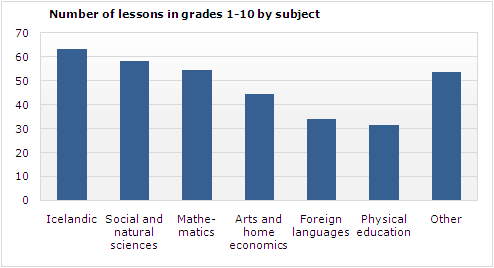According to a new law on compulsory schools from 2008 the annual school period for pupils should not be shorter than 9 months. The number of pupils’ school days during the school year should not be fewer than 180. The minimum weekly teaching time in grades 1 to 4 in compulsory education is 1,200 minutes (30 lessons), 1,400 minutes in grades 5 to 7 (35 lessons) and 1,480 minutes in grades 8 to 10 (37 lessons). When splitting these minutes into 40 minute lessons each pupil should get at least 336 weekly lessons during his ten years in compulsory education, or 33.6 per year on average.
A decrease in instruction time between school years
In the spring report schools are requested to give the weekly instruction time (in minutes) by subject. In grades 1 to 10 the total weekly instruction time has decreased by 6.8 lessons since the previous school year. During the school year 2007-2008 pupils in grades 1 to 10 received a total of 346.1 lessons per week, but one year later the number of lessons had dropped to 339.3 per week. The reduction is greatest in grade 5, or one lesson per week on average. If this instruction time will be maintained pupils will still receive more hours per week than the minimum stipulated by law. The decrease is greatest in ICT, 1.2 lessons and in Icelandic, 1.0 lesson, when the decrease in instruction time by subject is examined. The only subject where the instruction time is not reduced is English.
The data depict that a 6 year old child, that is starting compulsory education, can expect to receive 63 weekly lessons in Icelandic, split over the 10 years of compulsory education. The child can expect to get 58.1 weekly lessons in the natural and social sciences and 54.5 weekly lessons in mathematics. More than one-half (51.8%) of the instruction time in compulsory education is used for these subjects.

There are 179.5 school days on average
The school period is counted in school days, which are divided into teaching days, examination/assessment days and other teaching days. Other teaching days are days when teaching according to the timetable does not take place, such as when field trips and school trips are organised. The difference in the number of school days by grade during the school year 2008-2009 is not significant. The average number of school days for all grades was 179.5, which is an increase of 0.2 days from the previous school year. The number of examination days is lowest in grades 1-3 or 0.5 days. The number of examination days is highest in tenth grade or 4.3 days on average, which is almost 3 days less than during the previous school year.
There are 13 annual teachers’ working days without pupils
The average number of teachers’ working days without pupils last school year was 12.9. Teachers had 4.9 working days on average without students during the school year and 8.0 days before the start of the school year and/or after the school year ended.
On average the total number of teachers’ working days was 192 days, 179 with pupils and 13 without pupils. This is the same number of days as in 2007-2008.
Almost one out of four pupils receive special support
During the school year 2008-2009 10,650 pupils received some kind of special education or support, or 24.5% of all pupils, which is an increase of 10 pupils from the previous year. The largest proportion of pupils receiving support is found among pupils in fourth grade (9 year old pupils), or 28.1% of the cohort, but lowest among pupils in first grade, 19.3% of pupils. Of those 10,650 pupils receiving special education or support 62.5% were boys and 37.5% were girls. When comparing with data from previous years fewer pupils now only receive support in special education classrooms, while more pupils receive support both in special education classrooms and in the regular classroom.